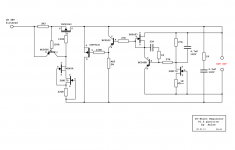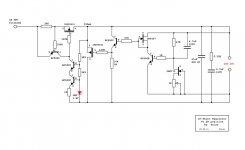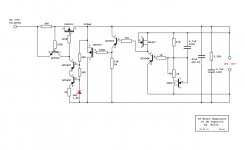Hi guys, is it the simplistic shunt reg v 1.2 superior to Twisted pear audio's Placid ? I suggest yes, but how much? Any suggestion?
thanks.
p.s. of course, to supply the Buffalo II.
thanks.
p.s. of course, to supply the Buffalo II.
Can you show us the Twisted pear audio's Placid ?
Have a look----------------
http://www.twistedpearaudio.com/power/placid.aspx
Hi guys, is it the simplistic shunt reg v 1.2 superior to Twisted pear audio's Placid ? I suggest yes, but how much? Any suggestion?
Not bad, but can be done better.
Single transistor as CCS is not very good choice, too low dynamic impedance.
"More devices" mix is better choice here to increase dynamic impedance.
Powering opamp from raw supply is not very good idea since you are relying only on opamp's PSRR. And opamp's PSRR will fall as frequency is increasing. Powering opamp from self regulating power supply is much better choice.
CFP after opamps is not best choice. Single device there is better choice.
Everything already mentioned here by Allen Wright and Maximus (Paul Hynes).
Hi guys, is it the simplistic shunt reg v 1.2 superior to Twisted pear audio's Placid ? I suggest yes, but how much? Any suggestion?
thanks.
p.s. of course, to supply the Buffalo II.
I compared vs Salas V1.0 remote sense (better Salas) & upgraded to Salas V1.2R (better than Salas V1.0 remote sense)🙂
I sold my Placid several months ago here.
Powering opamp from raw supply is not very good idea since you are relying only on opamp's PSRR. And opamp's PSRR will fall as frequency is increasing. Powering opamp from self regulating power supply is much better choice.
Agreed here. A simple mod for the Placid would be to feed the opamp from and RC filter such as Sulzer did ..... would likely improve high frequency PSRR. Ideally I'd want to feed the opamp from it's own output, but it would need to be tested for proper start up.
An externally hosted image should be here but it was not working when we last tested it.
thanks for infos, very useful. I get a BOSOZ preamp that i feed with +/-60V at
80 mA. Can I use the simplistic v 1.2 at that voltage? I read about high voltage Salas
regs but the maximum was +/-45V.
Can you help me?
regards.
80 mA. Can I use the simplistic v 1.2 at that voltage? I read about high voltage Salas
regs but the maximum was +/-45V.
Can you help me?
regards.
Yes, but rate all the capacitors for the worst case operating voltages they could see.
Check the dissipation of all semiconductors and all resistors.
The minimum input voltage will need to be at least 60+6V >66Vdc.
The maximum input voltage could be as much as 20% above this, i.e. ~79Vdc.
If you can prove to yourself that 80V cannot be exceeded then use 80V capacitors, if not then use 100V capacitors.
Check the dissipation of all semiconductors and all resistors.
The minimum input voltage will need to be at least 60+6V >66Vdc.
The maximum input voltage could be as much as 20% above this, i.e. ~79Vdc.
If you can prove to yourself that 80V cannot be exceeded then use 80V capacitors, if not then use 100V capacitors.
Also use 60V Zener and 470uF capacitor instead of the resistor and film in the voltage reference, and no trimmers in the Jfet underneath. Just tie G&S pins. Heat and high voltage will tend to show enough drift from the resistor Norton Vref otherwise. Do the 1.2R #post 3200.
@ Salas,
thanks for good news.I'll need only 120mA from CCS (80mA for BOSOZ and 40mA for the shunt) ;can I use TO220 devices in both CCS and shunt position or not? If yes, wich models? I've a lot of IRF 610 and 9610 , but you don't like this in the shunt position.
I'm correct?
best
Orazio
thanks for good news.I'll need only 120mA from CCS (80mA for BOSOZ and 40mA for the shunt) ;can I use TO220 devices in both CCS and shunt position or not? If yes, wich models? I've a lot of IRF 610 and 9610 , but you don't like this in the shunt position.
I'm correct?
best
Orazio
I am about to start building the Salas reg 1.2 pos. and neg. for a hybrid headphone amp (EHHA RevA). I am doing this per recommendation of Salas to use these schematics when no scope is available.
I will use one reg (per polarity) for two channels so I will set them at about 350mA.
Attached I have redrawn the schematics (as usual 😉) and marked the pinouts...
Q Did I get the SK's and 2N's right...?
Anything else that might have escaped me (I know it starts to get tiring...😀)
Thank you
I will use one reg (per polarity) for two channels so I will set them at about 350mA.
Attached I have redrawn the schematics (as usual 😉) and marked the pinouts...
Q Did I get the SK's and 2N's right...?
Anything else that might have escaped me (I know it starts to get tiring...😀)
Thank you
Attachments
@ Salas,
thanks for good news.I'll need only 120mA from CCS (80mA for BOSOZ and 40mA for the shunt) ;can I use TO220 devices in both CCS and shunt position or not? If yes, wich models? I've a lot of IRF 610 and 9610 , but you don't like this in the shunt position.
I'm correct?
best
Orazio
IRF9540 & 540 in the shunt positions and 1.2R schematics for TO-220. Else it will oscillate.
I am about to start building the Salas reg 1.2 pos. and neg. for a hybrid headphone amp (EHHA RevA). I am doing this per recommendation of Salas to use these schematics when no scope is available.
I will use one reg (per polarity) for two channels so I will set them at about 350mA.
Attached I have redrawn the schematics (as usual 😉) and marked the pinouts...
Q Did I get the SK's and 2N's right...?
Anything else that might have escaped me (I know it starts to get tiring...😀)
Thank you
The 2N5459s in the CCS tails will not take your projected voltage levels. Up to 28VinDC tops.
Thanks for the remark. What would be a suitable replacement for my target voltage?The 2N5459s in the CCS tails will not take your projected voltage levels. Up to 28VinDC tops.
Or would it be better to switch to V1.2R?
Last edited:
Switch to 1.2R. Use the BJT cascode tails examples.There is a LED in the BJT tail too, so you know its on.
For just 30V, BC550/560C can be also used instead of 546/556B if you already got some, also the designation for the CCS is not IRFP9610/610, just IRF9610/610.
what about big capacitance after shunt reg? The experts disagree; Russ White of TPA says that " .. the high capacitance defeat the purpose of shunt reg", while Erno Borbely told me that don't matter, and to try 10000uF after the reg. I'm using a simple shunt (CCS+zener+BJT+mosfet) to supply my BOSOZ, and I put 4x680uF Panasonic FC after each rail of regulator and all works perfectly. I don't have a scope, and ,of course, I don't know
about oscillations.Any suggestion?
Thanks
about oscillations.Any suggestion?
Thanks
That one has to do with the open loop analysis of each reg. There is no blanket answer. In general if the reg & load system are stable, the less extra capacitance the more open the bandwidth. If you had steady oscillations you would have much audible hum & buzz when feeding a low PSRR circuit. Yours is just a stabilizer, you describe no error loop amplification stage so to classify as a reg. I don't expect any phase difficulties if being a stabilizer is correct.
- Status
- Not open for further replies.
- Home
- Amplifiers
- Power Supplies
- The simplistic Salas low voltage shunt regulator



